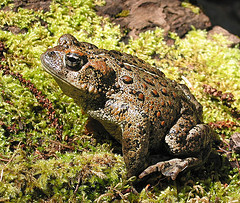Previous research has shown that higher levels of biodiversity leads to lower levels of infectious disease because of the “dilution effect,” where some species are poor hosts of the disease or may not be infected at all, slowing disease transmission.
The dilution effect has been studied in Lyme disease and West Nile.
A paper recently published in the Proceedings of the National Academy of Sciences shows the dilution effect at work in chytrid fungus infections in Western toads. Other news outlets have reprinted the press release from Oregon State University. (We have a OSU two-fer this week. Go Beavers.)
Read the original release via EurakAlert.
The press release does not make clear that this was a laboratory experiment, or that the experiment was conducted with tadpoles. The Western toad tadpoles were raised in aquaria with American bullfrogs and Cascades frogs. You can read the Ph.D. dissertation that is the basis for the paper here. (It’s a big PDF, but that shouldn’t be a surprise.)
The laboratory setting with just three species (well, four, if you count the fungus) makes the conclusion that much more striking. It would be interesting to see how these findings hold up in the field.
Read the PNAS paper here (fee or subscription required).
Read a conference summary of the research from the Ecological Society of America annual meeting here.
Photo: Western toad. Courtesy Oregon State University.

